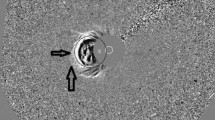Abstract
The 3D characteristics of the coronal mass ejection (CME) body and shock at different distances (R) from the Sun’s center have been determined for several fast halo CMEs based on data from the Large Angle and Spectrometric Coronagraph Experiment (LASCO): the positions of the CME body boundary and the related shock on their axes, the directions and velocities of these points, the distance between a shock and the CME body boundary ΔR(R), and the difference between the velocities of these structures ΔV(R) and their angular dimensions. It was shown that the character of variations in the positions and velocities of the CME body boundary and a shock differs at different distances. The dependences of parameter [ΔR/R cme](R), where R cme is the curvature radius of the CME body boundary on the CME axis, were constructed. The obtained dependence was compared with the ΔR/R cme (M A (R)) dependence. Here M A is the Alfvén Mach number. The relation of ΔR/R cme to M A was obtained by Russell and Mulligan (2002) for shocks in the Earth’s orbit. A comparison of [ΔR/R cme](R) performed in two ways makes it possible to conclude that shocks related to a CME body are piston-like, with the CME body as a piston, at least at a distance of R > 10R 0 (R 0 is the solar radius).
Similar content being viewed by others
References
Egorov, Ya.I., Study of the formation and shift of coronal mass ejections and related shock waves, Cand. Sci. (Phys.–Math.) Dissertation, Irkutsk, 2014.
Fainshtein, V.G., The expansion of a coronal mass ejection within LASCO field of view: Some regularities, Universal Heliophysical Processes, Proceedings of the International Astronomical Union, IAU Symposium, 2009, vol. 257, pp. 257–263.
Fainshtein, V.G., Tsivileva, D.M., and Kashapova, L.K., Determination of geometric and kinematical parameters of coronal mass ejections using stereo data, in Twelfth International Solar Wind Conference. AIP Conference Proceedings, 2010, vol. 1216, pp. 416–419.
Gopalswamy, N., Yashiro, S., Michalek, G., Stenborg, G., Vourlidas, A., Freeland, S., and Howard, R., The SOHO/LASCO CME catalog, Earth, Moon, Planets, 2009, vol. 104, nos. 1–4, pp. 295–313.
Gopalswamy, N. and Yashiro, S., The strength and radial profile of the coronal magnetic field from the standoff distance of a coronal mass ejection-driven shock, Astrophys. J. Lett., 2011, vol. 736, no. 5, p. L17.
Gosling, J.T., McComas, D.J., Phillips, J.T., and Bame, S.J., Geomagnetic activity associated with earth passage of interplanetary shock disturbances and coronal mass ejections, J. Geophys. Res., 1991, vol. 96, pp. 7831–7839.
Grechnev, V.V., Uralov, A.M., Chertok, I.M., Slemzin, V.A., Filippov, B.P., Egorov, Y.I., Fainshtein, V.G., Afanasyev, A.N., Prestage, N.P., and Temmer, M., A challenging solar eruptive event of 18 November 2003 and the causes of the 20 November geomagnetic superstorm. II. CMEs, shock waves, and drifting radio bursts, Sol. Phys., 2014, vol. 289, pp. 1279–1312.
Michalek, G., An asymmetric cone model for halo coronal mass ejections, Sol. Phys., 2006, vol. 237, pp. 101–118.
Russell, C.T. and Mulligan, T., On the magnetosheath thicknesses of interplanetary coronal mass ejections, Planet. Space Sci., 2002, vol. 50, pp. 527–534.
Savani, N.P., Shiota, D., Kusano, K., Vourlidas, A., and Lugaz, N., A study of the heliocentric dependence of shock standoff distance and geometry using 2.5D magnetohydrodynamic simulations of coronal mass ejection driven shocks, Astrophys. J., 2012, vol. 759, p. 103.
Sheeley, N.R., Jr., Wang, Y.-M., Hawley, S.H., et al., Measurements of flow speeds in the corona between 2 and 30 R &sun, Astrophys. J., 1997, vol. 484, pp. 472–478.
Thernisien, A.F.R., Howard, R.A., and Vourlidas, A., Modeling of flux rope coronal mass ejections, Astrophys. J., 2006, vol. 652, p. 763.
Vourlidas, A. and Bemporad, A., A decade of coronagraphic and spectroscopic studies of CME-driven shocks, AIP Conf. Proc., 2012, vol. 1436, pp. 279–284.
Xue, X.H., Wang, C.B., and Dou, X.K., An ice-cream cone model for coronal mass ejections, J. Geophys. Res., 2005, vol. 110, A08103.
Author information
Authors and Affiliations
Corresponding author
Rights and permissions
About this article
Cite this article
Fainshtein, V.G., Egorov, Y.I. Characteristics of the motion of coronal mass ejections and related shocks depending on the heliocentric distance. Geomagn. Aeron. 55, 1165–1170 (2015). https://doi.org/10.1134/S0016793215080071
Received:
Accepted:
Published:
Issue Date:
DOI: https://doi.org/10.1134/S0016793215080071




